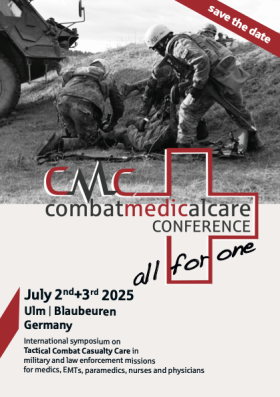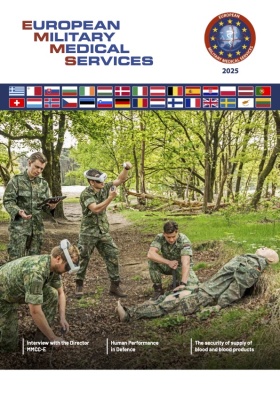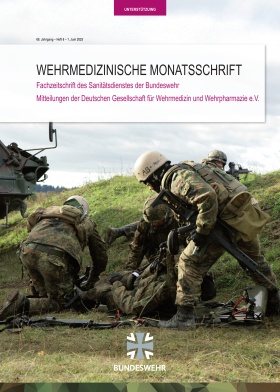
Article: Assistant Professor Goh Jit Khong Jake[1,2], Dr M Premikha[1]
Strategic Response to Mpox in the Singapore Armed Forces: Military Public Health Collaboration and Preparedness
1) Introduction
Mpox, a zoonotic viral disease caused by the monkeypox virus, has garnered global attention for its transmissibility and potential to cause outbreaks, particularly in densely populated environments.[1] This is of particular concern to military forces worldwide, where personnel often operate in close quarters, both domestically and during international deployments. Such conditions provide an ideal setting for the rapid spread of infectious diseases, which can compromise the health and operational readiness of the force.
The Singapore Armed Forces (SAF), recognizing the threat posed by mpox, has developed and implemented a comprehensive, phased response to mitigate the impact of mpox on its personnel. Drawing upon guidelines from key public health organizations, including Singapore’s Ministry of Health (MOH), the World Health Organization (WHO), and the Centers for Disease Control and Prevention (CDC), the SAF's approach emphasizes early detection, containment, and protection of its personnel through vaccinations.[2,3] Given the nature of SAF operations, which include deployments in diverse and potentially high-risk regions, a proactive stance on infectious disease management is critical.
This paper details the SAF’s mpox response from 2022 to 2024, emphasizing how military-specific challenges, such as deployment logistics, close living conditions, and the need to maintain operational continuity, were addressed by tapping into national and international public health strategies. Key elements of this response included enhanced border controls, targeted risk assessments, real-time surveillance, and efficient internal diagnostics, all underpinned by SAF’s collaboration with MOH and other national health partners. Together, these measures helped maintain continuity of operations while safeguarding personnel health.
By reflecting on the experiences and outcomes of mpox management in the SAF, this paper provides insights for future civil–military cooperation in managing zoonotic and high-consequence infectious diseases. SAF’s response offers a model of adaptability and resilience, contributing valuable lessons for military organizations and public health agencies striving to enhance preparedness in operational settings.
2) SAF’s Mpox Prevention Strategies 2022-2024
In response to the global mpox outbreaks of 2022 and 2024, the SAF implemented a phased prevention strategy to mitigate risks while maintaining operational readiness. SAF’s approach, grounded in national and international guides, evolved from early prevention measures to a more comprehensive response tailored to the changing epidemiology of mpox.[4]
Phase 1: Initial Response and Prevention (2022)
The global mpox outbreak in 2022, declared as a Public Health Emergency of International Concern (PHEIC) by the WHO, was primarily driven by the West African clade of the virus.[5] It affected numerous countries and posed a unique challenge to military organizations like the SAF, where personnel are deployed globally and may live in dense environments conducive for viral transmission.[6] The SAF’s initial response focused on:
a) Surveillance and Monitoring: The SAF established routine temperature screenings and symptom checks (e.g., fever, rash, lymphadenopathy), specifically targeting personnel returning from overseas. Symptom monitoring was essential in early identification and containment of potential cases, minimizing the risk of undetected spread.
b) Educational Efforts: To enhance awareness, the SAF launched educational initiatives that included the identification of mpox symptoms, routes of transmission (primarily through close contact with infectious lesions, body fluids, or respiratory droplets), best practices in personal hygiene and the importance of reporting symptoms promptly to prevent transmission. Awareness efforts extended to commanders and unit leaders, emphasizing the crucial role of leadership in ensuring compliance with preventive measures and fostering a culture of health vigilance within the ranks.
c) Isolation Preparedness: Given the rapid transmission potential of mpox, the SAF designated isolation facilities for suspected cases, ensuring that infections could be contained quickly. Personal protective equipment (PPE) stocks were maintained for healthcare providers. Protocols for isolation were developed, aligning SAF’s approach with national standards for infection control. SAF healthcare providers were briefed on infection prevention and control measures, ensuring readiness to manage potential cases safely.
d) Vaccination Preparedness: Although the SAF saw limited mpox cases in 2022, contingency plans were made for vaccine procurement, particularly for high-risk personnel, such as healthcare workers or those potentially deployed to regions with active outbreaks. Collaboration with MOH facilitated access to national mpox vaccine reserves, ensuring SAF had sufficient vaccines to protect high-risk personnel and bolster its military readiness.
These early interventions in 2022 laid the foundation for mpox preparedness within the SAF, emphasizing the importance of vigilance, education, and healthcare preparedness in managing potential outbreaks.
Phase 2: Enhanced Response & Adaptation (2024)
The 2024 outbreak differed from 2022 by involving both the West African (Clade IIb) and the more virulent Congo Basin (Clade I) clades.[7] The Congo Basin clade, with a higher case-fatality rate, poses a greater risk of severe illness, especially for immunocompromised individuals.[8] This difference necessitated an updated response strategy, with increased vigilance for severe cases. In 2024, while mpox continued to disproportionately affect high-risk groups, including men who have sex with men (MSM), there was evidence of transmission to vulnerable populations, such as pregnant women and children.[9,10] This increased the urgency for preventive efforts as servicemen could spread the virus to family members.
In August 2024, the WHO once again declared mpox a PHEIC due to renewed outbreaks of the virus and its potential to impact global health through sustained transmission.[11] Building on its 2022 experience, the SAF adapted its preventive strategies to meet the emerging epidemiological landscape. The SAF’s enhanced response includes:
a) Stepping Up Border Control Measures: The SAF strengthened border control at its ports of entry and intensified screening protocols for personnel returning from overseas, including temperature checks, health declarations and symptom monitoring. Border control measures were coordinated with Singapore's MOH and Immigration and Checkpoints Authority (ICA) to reduce the risk of imported mpox cases within military ranks.
b) Updating Instructions: The SAF issued updated instructions with clear operational and medical protocols for suspected and confirmed mpox cases. Standardized procedures for isolation, testing, and case management were developed, allowing for consistent application across both domestic and overseas deployments.
c) Improving Communication Efforts: The SAF adapted its communication strategy to provide timely updates on the evolving global situation, preventive measures and mpox symptoms through multiple channels, ensuring all personnel had access to accurate information. Regular briefings reinforced personal hygiene practices and symptom reporting, strengthening compliance among both personnel and commanders.
d) Conducting Risk Assessments for Overseas Deployments: Given the global nature of SAF operations, risk assessments were conducted for all overseas deployments. Through MOH, SAF assessed the mpox risk in various regions, particularly those with active community transmission. These assessments informed SAF's deployment protocols, ensuring that personnel deployed to high-risk areas adhered to preventive measures, with contingency plans in place should mpox cases arise.
e) Tracking Health of SAF Personnel: SAF maintained detailed tracking of personnel who had visited areas with known mpox transmission. Through comprehensive health declarations submitted by SAF personnel, the organization could monitor for symptoms and provide rapid medical support if necessary. Personnel returning from high-risk regions were subject to additional monitoring, including regular health checks and isolation protocols if mpox symptoms emerged.
f) Building Internal Diagnostic Capability: Recognizing the importance of prompt diagnosis, SAF collaborated with the Defence Science Organization (DSO), a national defence research and development organisation in Singapore developing technological solutions for defence and national security, to establish internal diagnostic capabilities. This included procuring and setting up diagnostic tools within SAF medical facilities to enable rapid mpox testing, allowing for independent, immediate responses in suspected cases. This capability reduced reliance on external resources and allowed SAF to respond more swiftly.
The SAF’s enhanced measures for mpox in 2024 reflect a coordinated, comprehensive approach that integrates surveillance, border control, risk assessment, and diagnostic capability. These measures underscore SAF’s commitment to operational readiness and safeguarding the health of its personnel, providing a model for managing infectious diseases within military contexts.[12]
Continued Vigilance in a Stabilizing Mpox Landscape
By November 2024, the global mpox situation had stabilized, although concerns persist regarding the virulent Clade I strain, which remains largely contained within Africa, with only isolated cases reported in the UK, Germany, Sweden, Thailand, and India. These cases have been closely monitored by local health authorities, and stringent containment measures have prevented further spread. In Singapore, there have been no reported cases of Clade I mpox so far. The absence of Clade I provides some relief, though ongoing preventive measures are critical to maintaining this status. The SAF remains prepared to respond swiftly should any cases emerge, leveraging its partnerships with national health authorities to mitigate risks and protect its personnel.
3) Collaboration of SAF with National Partners
The SAF has built strong partnerships with various national agencies, including the MOH, other ministries and its own Infectious Disease Specialist Advisory Board (IDSAB), to align its mpox response with Singapore’s public health strategy.[13] These collaborations have been essential for implementing rapid responses to prevent outbreaks in high-density environments typical of military settings.
Ministry of Health (MOH)
As Singapore’s key public health authority, the MOH played a central role in supporting SAF’s mpox response. From the onset of the mpox outbreaks in 2022 and 2024, the SAF ensured that its prevention and response measures were consistent with the public health guidelines issued by the MOH.[13] The MOH provided the SAF with up-to-date epidemiological data, public health recommendations, and access to resources essential to prevent the spread of mpox in military settings.
a) Coordinated Surveillance & Screening
The SAF adopted MOH-recommended screening protocols for personnel returning from overseas deployments, incorporating routine temperature checks, mandatory health declarations, symptom monitoring, and early identification of suspected cases. Through a collaborative data-sharing arrangement, the SAF received real-time epidemiological updates from MOH on mpox cases, enabling SAF to swiftly adapt its surveillance measures in response to emerging cases. This coordinated approach fostered a seamless flow of information, helping SAF integrate its tracking efforts with national surveillance systems to reinforce both civilian and military health security.
b) Public Health Messaging and Education
SAF’s public health messaging was developed with MOH’s guidance, ensuring scientific accuracy in mpox awareness campaigns. SAF educational campaigns promoted symptom recognition, transmission prevention and personal hygiene practices among SAF personnel. This alignment with MOH strengthened SAF’s internal communications, with unit leaders playing a pivotal role in ensuring adherence to best practices across all levels of personnel.
c) Access to National Vaccine & PPE Stockpiles
In collaboration with MOH, the SAF secured access to the national vaccine stockpile for mpox, allowing high-risk military personnel, such as healthcare workers and overseas-deployed individuals with potential exposure in mpox-affected regions, to receive prioritised vaccination if necessary. As of Nov 2024, given the absence of mpox cases within the SAF, vaccination for healthcare workers was deemed unnecessary. This partnership ensured that SAF’s vaccination strategy was integrated into the national framework, allowing military personnel to benefit from MOH’s vaccine distribution mechanisms. Similarly, while SAF maintains its own PPE stockpile, it also has access to the national PPE reserves managed by MOH. Although global supply chain disruptions were not as severe during the mpox outbreak compared to the COVID-19 pandemic, the lessons from COVID-19 emphasized the importance of preparedness for potential large-scale disruptions. Access to the national stockpile has been essential for maintaining resource availability and meeting increased demand during surges.
Infectious Disease Specialist Advisory Board (IDSAB)
Infection Control and Isolation Facilities
SAF’s infection control protocols were developed in consultation with the IDSAB. The IDSAB, established by SAF, is a panel of senior infectious disease and public health experts drawn from Singapore’s healthcare sector. This collaboration ensured that SAF’s protocols for handling suspected or confirmed mpox cases aligned with national standards. The SAF maintained standby plans to reinstate SAF isolation facilities that adhered to national public health requirements, ensuring rapid containment capabilities if cases emerged. Additionally, SAF medical personnel, trained by HQ Medical Corps, were equipped with infection control skills specifically tailored to handle mpox cases.
Interagency Collaboration for Contingency Planning
SAF’s engagement with MOH extended beyond immediate mpox response efforts to encompass long-term contingency planning for potential outbreaks. This forward-looking approach was designed to keep SAF’s response framework adaptable to evolving public health threats, particularly new or re-emerging infectious diseases like mpox. As part of this collaborative planning, the SAF joined forces with MOH and other relevant national agencies such as the Ministry of Home Affairs (MHA), to conduct joint exercises and planning sessions simulating public health emergencies. These exercises emphasized the importance of interagency coordination, enhancing operational readiness, and ensuring a rapid, integrated response in the event of an mpox outbreak within military and civilian populations. By refining response protocols through these simulations, SAF and its partners could achieve a more cohesive public health defense, enhancing the resilience of Singapore’s overall outbreak response framework.
In summary, the SAF’s partnerships with MOH, IDSAB and other national agencies has been instrumental in shaping a comprehensive, cohesive, and proactive approach to managing mpox outbreaks. These collaborations not only safeguarded SAF personnel but also aligned with Singapore’s broader public health objectives, strengthening the country’s ability to control and prevent mpox transmission.
4) Discussion
The SAF response to the mpox outbreaks in 2022 and 2024 exemplifies a robust, adaptable and well-coordinated effort to managing emerging infectious diseases within a military context. By integrating surveillance, border controls, operational guidelines, and internal diagnostic capabilities, the SAF mounted an effective defence against the potential spread of mpox among its personnel. These responses were shaped by the lessons learned from previous public health crises, including the COVID-19 pandemic, and were guided by best practices from both national and international public health agencies. This discussion evaluates SAF’s response, compares it with international standards, and explores areas for future enhancement to sustain readiness for emerging health threats.
Comparison with International Guidelines and Responses
SAF’s response strategy closely aligned with international guidelines from the World Health Organization (WHO) and the Centers for Disease Control and Prevention (CDC). WHO’s Health Emergency Preparedness and Response (HEPR) Framework and CDC’s mpox infection prevention and control guidelines emphasize the importance of surveillance, early detection, contact tracing, and case isolation as key pillars in managing outbreaks such as that of mpox.[2,3,14] The SAF’s implementation of border control measures, real-time surveillance, routine health screenings, and symptom monitoring closely aligns with these international standards. Additionally, SAF’s risk assessments for overseas deployments and internal diagnostic capabilities enable effective anticipation and management of disease transmission.
Comparatively, other military organizations have employed similar approaches in manging mpox and similar zoonotic disease. For instance, during the 2022 mpox outbreak, the UK Defence Medical Services (DMS) emphasized close collaboration with public health authorities, risk assessments for deployments, and quarantine measures for suspected cases.[15] SAF’s response, however, stands out due to its integration of internal diagnostic capabilities, which provided a distinct advantage. By establishing in-house diagnostics, SAF reduced reliance on external testing resources, enabling rapid detection and containment – a critical feature for military forces that may operate in remote or logistically challenging environments.
National Collaboration and the Role of SAF in Public Health
The SAF’s collaboration with national agencies, particularly MOH, illustrates the essential dynamics of successful civil-military cooperation (CMC) in infectious disease management. SAF’s approach aligns well with the WHO’s Emergency Management Cycle (EMC) framework, highlighting how structured partnerships, early engagement, and transparent protocols drive effective interagency response.[16] As highlighted in a scoping review by Janse et al., sustainable CMC partnerships require a clear operational perspective and alignment across organizational cultures – elements SAF achieved through its joint simulations, data sharing, integrated surveillance, border controls and coordinated resource access with MOH.[16] SAF’s experience underscores the potential of CMC to support not only operational readiness but also public health resilience by linking military preparedness to broader civilian health protection. This alignment serves as a model for how military and civilian sectors can address complex public health threats collaboratively.
Limitations of the SAF Mpox Response
While the SAF’s response was largely effective, it was not without limitations. One significant challenge was the limited global supply of mpox vaccines during the 2022 and 2024 outbreaks.[17] The sudden surge in demand for mpox vaccines, coupled with manufacturing bottlenecks, made it difficult for many countries to procure sufficient vaccine doses to cover their high-risk populations.[17] Although SAF, in coordination with MOH, successfully prioritized vaccination for its high-risk personnel, the reliance on global limited global supplies underscores the vulnerability of smaller nations to global vaccine shortages. This challenge suggests the need for strategic vaccine stockpiling or pre-arranged procurement agreements to mitigate future shortages.
Another limitation involves the resource demands of SAF’s internal diagnostic capabilities. While in-house diagnostics provided a rapid response advantage, deploying and sustaining these tools is resource-intensive and requires robust logistical support. In remote or deployed environments like naval ships, supply chain disruptions or infrastructure constraints could hinder the swift deployment or maintenance of diagnostic tools. This limitation emphasizes the need for more portable diagnostic solutions and adaptable infrastructure to support rapid response in isolated settings.
Areas for Further Strengthening
The evolving nature of infectious disease threats, including mpox, underscores the need for ongoing improvements in military and public health response strategies. Building on experiences and lessons learned from the mpox outbreaks, four key recommendations are proposed to strengthen preparedness for military and public health agencies.
First, expanding in-house diagnostic capabilities through mobile, rugged diagnostic units would enable rapid testing in remote or resource-limited settings, allowing for faster response times during deployments. Second, to address global supply chain vulnerabilities revealed during the COVID-19 pandemic18, strategic stockpiling of vaccines and PPE specifically tailored to military and high-density settings is recommended, reducing dependence on global supplies during future outbreaks. Additionally, partnerships with vaccine manufacturers could be explored to secure early access to vaccines for high-risk personnel. Third, enhanced digital communication platforms are recommended to improve real-time information dissemination, ensuring that infection control updates reach personnel across all levels, particularly those in dispersed or deployed locations. Lastly, long-term health monitoring and surveillance are critical. Continued monitoring of personnel exposed to mpox, alongside broader zoonotic disease surveillance, will help identify and mitigate future health risks to military and public health operations. This includes vigilance for emerging threats, such as other clades of mpox like Clade I, which has yet to appear in Singapore but remains a potential risk. Deepening collaboration with national health agencies and international health bodies will enable effective data-driven responses, enhancing overall resilience and preparedness.
5) Conclusion
The SAF demonstrated an effective, adaptive approach to managing the 2022 and 2024 mpox outbreaks, underscoring its commitment to public health and operational readiness. By aligning with national and international guidelines, SAF implemented strategic measures – including enhanced border controls, in-house diagnostic capabilities, and targeted surveillance – while leveraging strong collaboration with MOH. This partnership allowed SAF to integrate its efforts with broader public health objectives, strengthening both military and civilian health security.
SAF’s phased mpox response reflects a critical evolution in military infectious disease management. Initial measures in 2022 focused on surveillance, education, and isolation, forming a foundation that expanded in 2024 to include risk assessments, enhanced communication, and rapid testing capabilities. These measures mirror an emerging global trend towards integrating military health efforts with public health strategies, especially for zoonotic diseases that can affect both military and civilian populations. A distinctive feature of SAF’s response was its integration with national public health frameworks, facilitated by MOH’s data-sharing and resource support. This civil–military cooperation has strengthened Singapore’s public health defences, highlighting the role of military health services in pandemic preparedness and reinforcing SAF as a proactive partner in broader health resilience. SAF’s continuous learning from previous outbreaks, such as COVID-19, reinforces the importance of institutional memory and adaptive preparedness plans.
In conclusion, SAF’s mpox response contributes to the evolving field of military public health preparedness. Through strategic foresight, adaptive measures and effective collaboration, the SAF exemplifies the military’s critical role in supporting national health while maintaining operational readiness. These insights provide valuable guidance for future civil-military partnerships in managing infectious diseases.
Authors & Affiliations
Assistant Professor Goh Jit Khong Jake[1,2], Dr M Premikha[1]
[1]Force Health Group, Headquarters Medical Corps, Singapore Armed Forces, Ministry of Defence, Singapore
[2]Saw Swee Hock School of Public Health, National University of Singapore, Singapore
Corresponding Author
Name: Assistant Professor Goh Jit Khong Jake
Workplace Address: Force Health Group, Headquarters Medical Corps, Singapore Armed Forces, 701 Transit Road, #02-03, Singapore 778910
Email Address: [email protected]
Mobile Number: +65 9298 6356
Details of Ethics Approval: Not required.
Disclosure of Interests: The authors declare that they have no competing interests.
Funding: This study was not funded.
Contribution to Authorship
- Assistant Professor Goh Jit Khong Jake, conducted a literature search, created the manuscript structure and drafted all sections of the manuscript.
- Dr M Premikha co-conducted a literature search, reviewed and edited all sections of the manuscript.
References
- Thornhill, J. P., Barkati, S., Walmsley, S., et al. (2022). Monkeypox virus infection in humans across 16 countries—April–June 2022. New England Journal of Medicine, 387 (8), 679-691. https://doi.org/10.1056/NEJMoa2207323
- World Health Organization. (2023). Strengthening the global architecture for health emergency prevention, preparedness, response and resilience. https://www.who.int/publications/m/item/strengthening-the-global-architecture-for-health-emergency-prevention--preparedness--response-and-resilience
- Centers for Disease Control and Prevention. (2022). Monkeypox and smallpox vaccine guidance. https://www.cdc.gov/vaccines/hcp/vis/vis-statements/smallpox-monkeypox.html#:~:text=JYNNEOS%E2%84%A2%20is%20usually%
20administered,%2C%20monkeypox%2C%20or%20other%20orthopoxviruses.
- Bunge, E. M., Hoet, B., Chen, L., et al. (2022). The changing epidemiology of human monkeypox—A potential threat? A systematic review. PLoS Neglected Tropical Diseases, 16(2), e0010141. https://doi.org/10.1371/journal.pntd.0010141
- World Health Organization. (2022, July). WHO Director-General declares the ongoing monkeypox outbreak a Public Health Emergency of International Concern. https://www.who.int/europe/news/item/23-07-2022-who-director-general-declares-the-ongoing-monkeypox-outbreak-a-public-health-event-of-international-concern
- Rimoin, A. W., Mulembakani, P. M., Johnston, S. C., et al. (2010). Major increase in human monkeypox incidence 30 years after smallpox vaccination campaigns cease in the Democratic Republic of Congo. Proceedings of the National Academy of Sciences of the United States of America, 107 (37), 16262-16267. https://doi.org/10.1073/pnas.1005769107
- Verma, A., Nazli Khatib, M., Datt Sharma, G., et al. (2024). Mpox 2024: New variant, new challenges, and the looming pandemic. Clinical Infection in Practice, 24(100394), 100394. https://doi.org/10.1016/j.clinpr.2024.100394
- Beer, E. M., & Rao, V. B. (2019). A systematic review of the epidemiology of human monkeypox outbreaks and implications for outbreak strategy. PLoS Neglected Tropical Diseases, 13(10), e0007791. https://doi.org/10.1371/journal.pntd.0007791
- Nachega, J. B., Mohr, E. L., Dashraath, P., et al. (2024). Mpox in pregnancy — risks, vertical transmission, prevention, and treatment. The New England Journal of Medicine, 391(14), 1267–1270. https://doi.org/10.1056/nejmp2410045
- Sanchez Clemente, N., Coles, C., Paixao, et al. (2024). Paediatric, maternal, and congenital mpox: a systematic review and meta-analysis. The Lancet. Global Health, 12(4), e572–e588. https://doi.org/10.1016/s2214-109x(23)00607-1
- World Health Organization. (2024). WHO Director-General declares mpox outbreak a public health emergency of international concern. https://www.who.int/news/item/14-08-2024-who-director-general-declares-mpox-outbreak-a-public-health-emergency-of-international-concern
- Ho, Z. J. M., Hwang, Y. F. J., & Lee, J. M. V. (2014). Emerging and re-emerging infectious diseases: Challenges and opportunities for militaries. Military Medical Research, 1(1), 21. https://doi.org/10.1186/2054-9369-1-21
- Ministry of Health, Singapore. (2024). Update on Public Health Preparedness Measures for Mpox Clade I. https://www.moh.gov.sg/newsroom/update-on-public-health-preparedness-measures-for-mpox-clade-i
- CDC. (2024, September 13). Mpox infection prevention and control in healthcare settings. https://www.cdc.gov/mpox/hcp/infection-control/healthcare-settings.html
- Woolley, S. D., Dermont, M., Adam, M., et al. (2023). The 2022 monkeypox outbreak: A UK military perspective. Travel Medicine and Infectious Disease, 52(102540), 102540. https://doi.org/10.1016/j.tmaid.2022.102540
- Janse, J., Kalkman, J. P., Burchell, G. L., Hopperus Buma, A. P. C. C., Zuiderent-Jerak, T., Bollen, M. T. I. B., & Timen, A. (2022). Civil-military cooperation in the management of infectious disease outbreaks: a scoping review. BMJ global health, 7(6), e009228. https://doi.org/10.1136/bmjgh-2022-009228
- Schaefer, G. O., Emanuel, E. J., Atuire, C. A., Leland, R. J., Persad, G., Richardson, H. S., & Saenz, C. (2023). Equitable global allocation of monkeypox vaccines. Vaccine, 41(48), 7084-7088. https://doi.org/10.1016/j.vaccine.2023.07.021
- Trump, B. D., Golan, M. S., Keisler, J. M., Cegan, J. C., & Linkov, I. (2022). Vaccine supply chain: Resilience-by-design and resilience-by-intervention. Vaccine, 40(12), 1695–1698. https://doi.org/10.1016/j.vaccine.2022.02.036
Date: 02/06/2025











